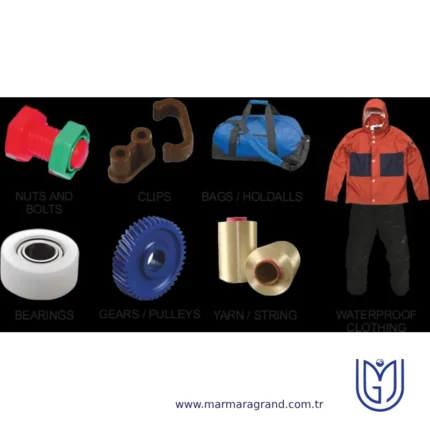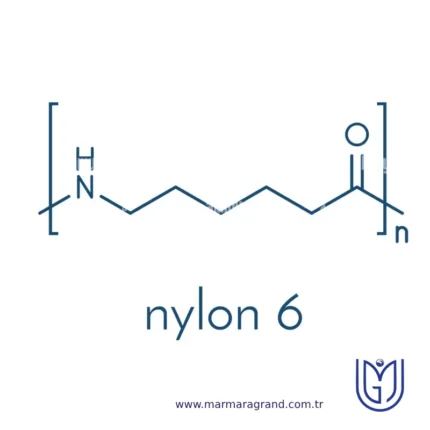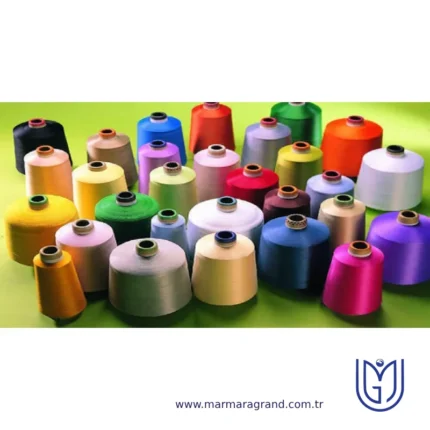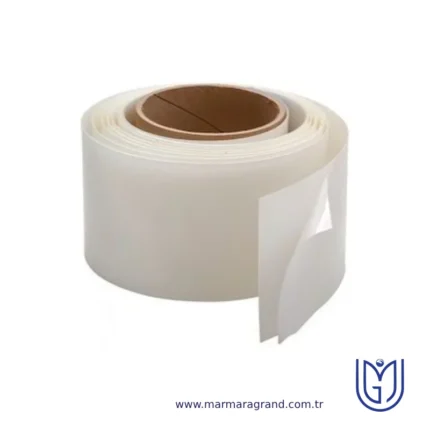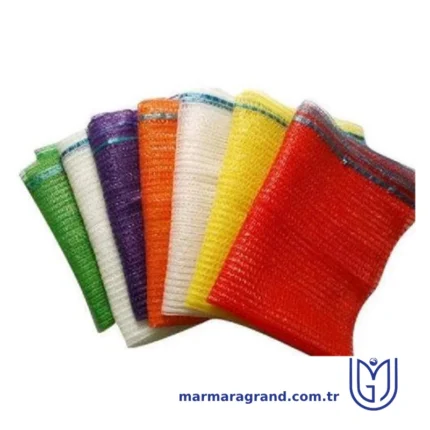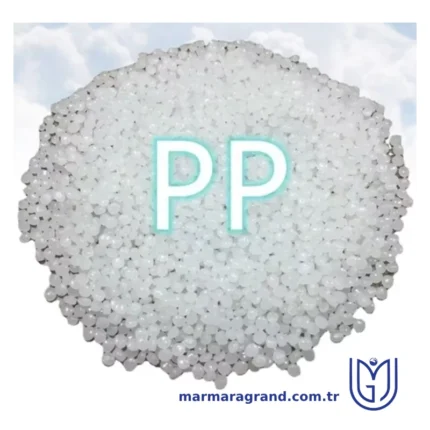Nylon 6
Nylon 6 is a synthetic engineering thermoplastic belonging to the polyamide (PA) family. It is widely used for its high strength, durability, thermal resistance, and chemical stability. Nylon 6 is synthesized from a single monomer, caprolactam, through ring-opening polymerization. This makes Nylon 6 easier to produce and process.
PropertiesNylon 6 is a strong, lightweight, and durable engineering thermoplastic known for its excellent mechanical and thermal properties. It has high tensile strength, toughness, and impact resistance, making it suitable for demanding applications. It also exhibits good wear resistance, low friction, and excellent abrasion resistance, which enhances its longevity in mechanical parts. Nylon 6 has a melting point of approximately 220°C and maintains stability over a wide temperature range. It offers good chemical resistance to oils, greases, and many solvents but is sensitive to strong acids and bases. One of its notable characteristics is its high moisture absorption, which can affect its mechanical strength and dimensional stability. Nylon 6 also has good electrical insulating properties, making it useful in electrical and electronic applications. Additionally, it is easily processable through injection molding, extrusion, and fiber spinning, allowing for its widespread use in textiles, automotive components, and industrial applications.
StructureNylon 6 is a synthetic polymer belonging to the polyamide family, characterized by its repeating units derived from caprolactam through a ring-opening polymerization process. The molecular structure of Nylon 6 consists of a linear chain of amide (–CONH–) linkages interspersed with six-carbon alkyl segments, forming a highly regular and symmetrical backbone that contributes to its notable mechanical strength, thermal stability, and chemical resistance. Unlike Nylon 6,6, which is synthesized from two different monomers, Nylon 6 is synthesized from a single monomer, ε-caprolactam, which undergoes polymerization through successive opening of the lactam ring, resulting in a continuous chain structure. The presence of hydrogen bonding between adjacent polymer chains enhances intermolecular interactions, leading to high crystallinity and improved tensile properties. This structural arrangement imparts Nylon 6 with desirable characteristics such as high flexibility, durability, and resistance to abrasion, making it widely utilized in textiles, engineering plastics, and industrial applications.
Applications of Nylon 6
- Textiles and Fabrics: Nylon 6 is widely used in the textile industry to produce items such as hosiery, swimwear, activewear, and undergarments due to its elasticity, strength, and smooth texture.
- Industrial Uses: Its high tensile strength and abrasion resistance make Nylon 6 suitable for manufacturing ropes, fishing nets, conveyor belts, and tire cords.
- Automotive Components: Nylon 6 is utilized in producing various automotive parts, including gears, bearings, and under-the-hood components, because of its durability and thermal stability.
- Consumer Goods: Common household items like toothbrush bristles, combs, and kitchen utensils are often made from Nylon 6 due to its resilience and ease of molding.
- Engineering Plastics: Nylon 6 is used in the production of engineering plastics for applications such as gears, bearings, and other mechanical components, owing to its strength and wear resistance.
Advantages of Nylon 6
- High Strength and Durability: Nylon 6 exhibits excellent tensile strength, making it suitable for products requiring long-lasting performance.
- Flexibility and Elasticity: The material offers good flexibility and can return to its original shape after stretching, which is beneficial for textile applications.
- Chemical Resistance: Nylon 6 is resistant to a wide range of chemicals, including oils and solvents, enhancing its suitability for various industrial applications.
- Thermal Resistance: With a high melting point, Nylon 6 can withstand elevated temperatures, making it appropriate for applications involving heat exposure.
- Lightweight: Nylon 6 is lighter than many metals, which is advantageous in applications where weight reduction is desired.
Disadvantages of Nylon 6
- Moisture Absorption: Nylon 6 is hygroscopic and can absorb moisture from the environment, leading to dimensional changes and potential degradation of mechanical properties.
- UV Sensitivity: Prolonged exposure to ultraviolet light can cause Nylon 6 to degrade, leading to discoloration and loss of strength.
- Lower Impact Resistance: Compared to some other engineering plastics, Nylon 6 may exhibit lower impact resistance, which could limit its use in high-impact applications.
- Processing Challenges: Nylon 6 requires careful control during processing, as it is sensitive to moisture and can degrade if not properly dried before molding.
Nylon 6-6
Nylon 66 is a type of synthetic polymer belonging to the nylon family of polyamides. It was first developed by Wallace Carothers and his team at DuPont in 1935. Nylon 66 is widely used due to its excellent mechanical properties, high thermal resistance, and chemical stability.
Structure
Nylon 66 is a synthetic polyamide with a repeating molecular structure formed through the condensation polymerization of hexamethylenediamine and adipic acid. The polymer consists of amide (-CONH-) linkages connecting alternating units of six carbon atoms from each monomer, resulting in a linear, highly ordered structure. This arrangement allows strong hydrogen bonding between polymer chains, enhancing its strength, rigidity, and thermal resistance. The repeating unit in Nylon 66 contains both aliphatic and amide groups, contributing to its balanced combination of flexibility and toughness. The presence of these intermolecular forces gives Nylon 66 its high melting point, excellent wear resistance, and mechanical stability, making it a widely used material in engineering and industrial applications.
Properties
Nylon 66 exhibits a combination of excellent mechanical, thermal, and chemical properties, making it highly suitable for various industrial applications. It has high tensile strength, toughness, and rigidity, which contribute to its durability and resistance to wear and abrasion. Its high melting point, typically around 255°C, allows it to maintain structural integrity under elevated temperatures. Nylon 66 also has good chemical resistance, particularly against oils, solvents, and many hydrocarbons, though it can absorb moisture, which may affect its mechanical properties. It has low friction and self-lubricating properties, making it ideal for applications requiring smooth movement and reduced wear. Additionally, Nylon 66 has good electrical insulation properties, making it useful in electrical and electronic components. Its ability to be easily molded and processed further enhances its versatility in manufacturing.
Applications of Nylon 66:
- Automotive parts such as gears, bearings, fuel lines, and radiator tanks
- Electrical and electronic components like connectors, cable ties, and insulators
- Industrial machinery components, including conveyor belts and mechanical fasteners
- Textiles and fibers used in carpets, ropes, parachutes, and outdoor wear
- Consumer goods such as sports equipment, kitchen utensils, and zippers
- Packaging materials, especially in films and coatings for food and medical applications
- High tensile strength and durability
- Excellent resistance to wear, abrasion, and impact
- High melting point and good thermal stability
- Good chemical resistance to oils, solvents, and hydrocarbons
- Low friction and self-lubricating properties
- Good electrical insulation properties
- Easily moldable and processable for various applications
- Absorbs moisture, which can affect mechanical and dimensional stability
- Can degrade under prolonged exposure to UV light without proper additives
- More expensive than other types of nylon, such as Nylon 6
- Can be attacked by strong acids and bases
polypropylene (PP Textile)
Polypropylene (PP) textile grade refers to a specialized form of polypropylene resin engineered for textile applications. It is a lightweight, synthetic polymer that offers durability, chemical resistance, and cost-effectiveness. This grade of PP is designed specifically for fiber production, which is then converted into woven, nonwoven, or knitted fabrics for various applications.
StructurePolypropylene (PP) textile grade is a lightweight, semi-crystalline thermoplastic polymer composed of repeating propylene (C₃H₆) units. It is primarily found in the isotactic form, where the methyl (-CH₃) groups are aligned on the same side of the polymer chain, resulting in high crystallinity (50-70%) and enhanced mechanical properties. This structure gives polypropylene excellent tensile strength, flexibility, and durability, making it suitable for various textile applications. With a low density of around 0.90-0.91 g/cm³, it is one of the lightest synthetic fibers available. Additionally, it is highly hydrophobic, meaning it does not absorb moisture, which makes it ideal for moisture-wicking applications.
PropertiesPolypropylene (PP) textile grade is a lightweight and durable synthetic fiber with a unique combination of physical, mechanical, thermal, and chemical properties. It has a low density of around 0.90-0.91 g/cm³, making it one of the lightest synthetic fibers available, while its hydrophobic nature prevents moisture absorption, ensuring quick drying and resistance to mildew. The material exhibits high tensile strength, good elongation, and excellent abrasion resistance, making it ideal for applications requiring durability, such as ropes, carpets, and industrial fabrics. With a melting point of approximately 165°C, polypropylene offers good thermal stability, although it has a lower heat resistance compared to materials like polyester and nylon. Chemically, it is highly resistant to acids, alkalis, and organic solvents, but it has a low affinity for dyes, requiring special treatments for coloration. While it is susceptible to UV degradation, stabilizers can be added to improve its resistance to sunlight. Additionally, polypropylene is recyclable, resistant to mold and bacteria, and easy to process into various forms such as fibers and nonwoven fabrics. These properties make it a popular choice for applications in nonwoven textiles, medical fabrics, sportswear, upholstery, and filtration materials.
ApplicationsPolypropylene textile-grade fibers are widely used in various industries due to their lightweight, durability, and moisture-resistant properties. Some key applications include: Application
- Nonwoven Fabrics: Used in medical textiles, surgical masks, hygiene products (diapers, sanitary pads), and geotextiles.
- Ropes and Nets: High-strength and lightweight ropes for marine, fishing, and industrial uses.
- Carpets and Upholstery: Used in household and commercial carpets due to stain resistance and durability.
- Sportswear and Activewear: Moisture-wicking properties make it suitable for athletic clothing, socks, and thermal wear.
- Filtration Fabrics: Employed in air and liquid filtration systems due to its chemical resistance.
- Industrial Textiles: Reinforcement fabrics for automotive, construction, and packaging applications.
Advantages
- Lightweight: One of the lightest synthetic fibers, making it comfortable and cost-effective in applications.
- Moisture-Resistant: Does not absorb water, making it quick-drying and resistant to mold and mildew.
- High Tensile Strength: Strong and durable, suitable for heavy-duty textile applications.
- Chemical and Stain Resistance: Resists acids, alkalis, and organic solvents, ensuring longevity.
- Thermal Insulation: Low thermal conductivity makes it useful in cold-weather garments.
- Recyclable: Eco-friendly as it can be melted and reused.
Disadvantages
- Low Dyeability: Has a low affinity for dyes, requiring special treatments to achieve vibrant colors.
- UV Sensitivity: Prolonged exposure to sunlight can degrade the fibers unless UV stabilizers are added.
- Low Heat Resistance: Begins to soften at relatively low temperatures (~165°C), limiting its use in high-temperature applications.


